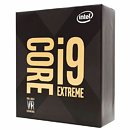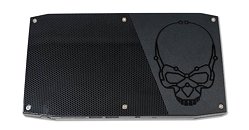Tuesday, July 10th 2018

Intel to Kill off The "Extreme Edition" Brand Extension
Intel is allegedly killing off the "Extreme Edition" brand extension it has been using to denote its flagship client-segment products, such as processors and NUCs. This, according to industry observer François Piednoël. This could also mean the retirement of related elements such as the iconic Intel Skull, and the black and silver packaging. What Intel is replacing this moniker with, remains a mystery.
Intel currently assigns the "Extreme" extension to only one client-segment product, the Core i9-7980XE. With the advent of the 28-core client-segment processor on a new motherboard platform, Intel could find itself tough to justify the extension on the "Basin Falls" (LGA2066) platform. The company is planning to launch new 20-core and 22-core LGA2066 processors, besides its 28-core processor on the new platform. The Extreme extension is also used on the company's "Skull Canyon" NUC.
Source:
François Piednoël (Twitter)
Intel currently assigns the "Extreme" extension to only one client-segment product, the Core i9-7980XE. With the advent of the 28-core client-segment processor on a new motherboard platform, Intel could find itself tough to justify the extension on the "Basin Falls" (LGA2066) platform. The company is planning to launch new 20-core and 22-core LGA2066 processors, besides its 28-core processor on the new platform. The Extreme extension is also used on the company's "Skull Canyon" NUC.


31 Comments on Intel to Kill off The "Extreme Edition" Brand Extension
i9 = HEDT
i7 = Mainstream High-end
i5 = Mainstream
i3 = Low-end / Economical
Would definitely streamline the branding and be more straightforward imho.
Intel is already in disarray...
2066 is due for a refresh anyway (as in new CPU's). i9-7980XE is a joke price/perf
Man those were the days, when AMD beat Intel to 1GHz, and Intel being the reactionist bastards they are, created an architecture solely to gain clockspeed advantage and beat AMD to 2, 3, and 4GHz. Then AMD pulled an Intel and beat them to 5. Thanks to Israel, Intel has been running what is basically a heavily modfied Pentium /// architecture to keep the IPC advantage since 2006 while being shady anti-competive bastards behind the scenes. The funniest thing is no one actually knew how bad Netburst sucked until Conroe arrived. SSE ops in 1 clock cycle meant that Conroe 2GHz matched Netburst 4.
The Quad-core Conroe Extreme Editions from 2007-up set a performance standard.
Now that AMD is competitive again, we have that and more for Goodwill P4 PC money.
I'd love to see higher clockspeed on Zen now. Would be nice with 4.5+ on the 7nm CPU's.. All core OC.. (and duo/single core boost out of the box)
Nobody didn't know Netburst sucked? Ehh.. :D I had maybe one or two friends who had a P4 on their PCs, every other had AMD XP or A64 CPUs since they were faster and cheaper. Especially when overclocked, they wiped the floors with hot and crappy Pentium 4s.
www.techpowerup.com/forums/threads/upgrade-fx8320-tips.245852/page-2#post-3868642
Intel need to get their game up since ryzen is starting to dominate.
1. The P6 µArch was first shows in the Pentium Pro, with MMX added for Pentium 2, and SSE for Pentium 3.
2. The P6 x86 core was replaced in the Sandy Bridge era, with the Sandy Bridge x86 core (after the elimination of the Northbridge, with the IMC moving with Nehalem, and PCIe root in Lynnfield).
You can read David Kanter's 20-page long dives if you want more details, but that's the 2 line summary.